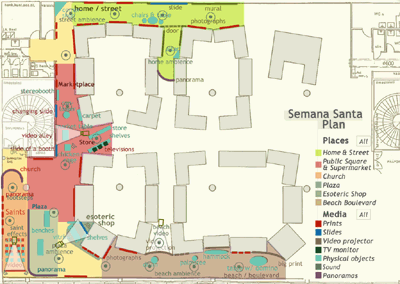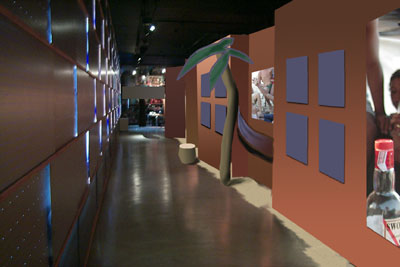|
ID SEMINAR. Giedre Kligyte (UIAH Media Lab, 2000)Displaying CultureDesigning interaction for exhibitsThe main goal of Semana Santa exhibition is to explore ways of using new technologies in exhibit spaces. In collaboration with anthropology students we tried to reconstruct the living conditions of Venezuelan people in Carúpano.

The exhibition consists of several 'stations' which present real locations at Carúpano. The design method is theatrical illusion – the feeling of real presence is created using only few actual items. The emphasis is on media elements – sounds and visuals, which we all agreed, are richest in content most eye-catching and immersive. "Among our goals was to create an interactive experience that makes use of technology to access emotional memory and play with the idea of space. " We rather focused on emotional experience, than tried to deliver information and knowledge. In order to achieve that we tried to keep the interaction and technology as transparent as possible. We wanted the user to feel like an active visitor of the different culture, who is anxious to see and explore it. I was responsible for the beach station design and mainly focused on finding a way to display a vast amount of video material and designing interaction for video projection. The first thing we agreed on was, that the interaction must have an element of a game in order to capture visitor’s attention. It’s difficult to keep people’s attention just by showing half an hour of video, no matter how rich is the material. In order to create motivation for a visitor to stay longer we designed an interactive drum interface, which goes nicely with the main concept of the exhibition – avoiding direct user contact with technology.

We decided to make a series of several short video loops, out of huge amount of video material. They appear on the screen in random order, creating new narrative every time. One video loop lasts about 4 minutes and initially was not to be changed until it runs at least once. A visitor changes one video piece to other by hitting touch sensitive drum. After the video loop has played once it jumps back to the beginning and keeps running with it’s volume down until somebody triggers the next one. But "field" testing in actual exhibition space showed, that my expectations about people’s behavior and perception were slightly wrong. Observing visitors brought up new questions and after a week I did some changes to the drum interface. First mistake was, that we tried to avoid any text comments and explanations in the exhibition space. Some complained, that it’s difficult to locate yourself anywhere if you don’t have any information beforehand. People are used to explain things to themselves and they expect and enjoy "understanding". In this way the "feeling" we offered, was not accepted very well. I personally feel, that many important things were left out because people simply didn’t understand, what was happening. The first change to interactive beach video projection was written explanation of how the drum works. As we initially thought – if people see the drum, they are going to play it. In this way they become an element of exhibition themselves and perform the show to others. (In order to avoid flashing changes we didn’t make the drum to react to every single hit at the beginning). But seems, that people are a bit shy to perform publicly and would hit the drum only once expecting immediate response. If not, they would say, that "it’s not working". The local bi-weekly paper Lansiväylä wrote an article (Länsiväylä keskiviikko 26.4., Kulttuuri, p. 9), where the vulnerability of technology in expositions like ours was commented. So after a week of failures I made the drum to react to any hit. Basically it functions just as a switch now. The loop system we made was supposed to force people to commit themselves and wait for one video loop to end in order to be able to make changes. But testing brought some corrections – a fair question "why I should commit to something I don’t know?" came up. With the way interaction is now a person can explore all the video pieces whenever s/he wants and then decide if s/he wants to see the rest. To my opinion it ads more variety and value to the narrative structure and gives more pleasant user experience. |